Cable TV Statistics for 2024: Stability and Change

Table of Contents
Cable television has evolved from a simple way to watch premium channels to something indispensable to many modern homes, complete with hundreds of channels worldwide for every audience under the sun. To completely understand it would be a monumental undertaking, yet to know nothing about it would mean that there would be a gap in your cultural awareness that would only stand to hurt you in the future.
And while we aren’t imploring you to start watching cable every night (unless you would like to), you can learn from looking into the industry, programming, and viewing trends from recent years. Let’s look a little more into some numbers and facts to better understand cable TV in 2022 and try to see what else we can find.
Who is Watching?
The first question you will want to ask when considering who is watching cable TV is answering the question of who is watching TV at all? The answer, at least in the United States, remains practically everyone.
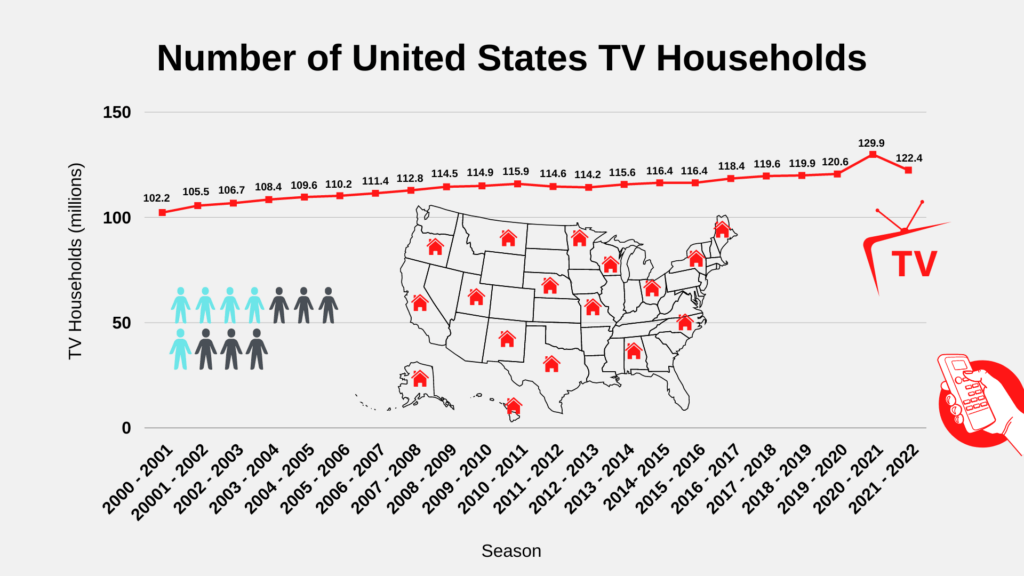
You can see from the graphic that there has been an overall trend upwards (and very few dips) in the number of households watching TV over the last two decades. This may be because there are more households in the country from population growth or partly because television is so common in the United States.
- There is an interesting divide among races or ethnicities of those who watch TV.
- Rates of traditional live TV watching were five hours and 31 minutes per day for Black adults. Among Hispanic adults, this rate was two hours and 45 minutes per day. And among Asian-American adults? Only one hour and 51 minutes per day.
- As a reminder, these numbers did not include streaming video or video-on-demand services.
- Older people watch more television. While the reasons could be many, the data by Nielsen clearly shows that younger people watch, on average less than two hours a day of television. In comparison, people 65 and older will watch upwards of seven hours and fifteen minutes each day (which is almost half of time spent awake.
- Similarly, regarding Cable TV, it seems that it’s mostly older people paying for it, either because they are less comfortable or interested in streaming options or because they’re more likely to use it often. Here’s the breakdown:

More Channels Than Your Entire Family Could Ever Watch
First, look at how many cable channels are available nationwide and how that number has grown (or more recently stagnated) over the years.
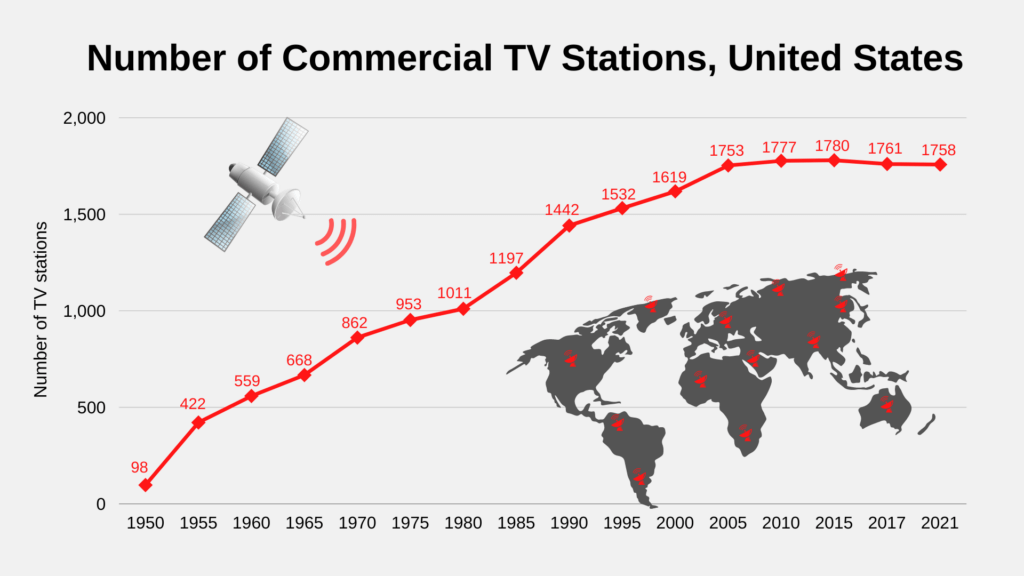
While the graph above goes in five-year intervals, that’s generally all that is needed to show the overall trend. Since the conception of and first widespread use of cable networks, more commercial channels have appeared to cater to specific markets (or perhaps to compete specifically with already existing channels).
When looking at the chart above, it’s also essential to consider that channels, especially the lesser known ones, change hands frequently. While the numbers in more recent years may appear stagnant, a regular turnover is created in response to audience ratings, changes in the cultural landscape, and many other factors.
And how many original scripted shows are being produced?
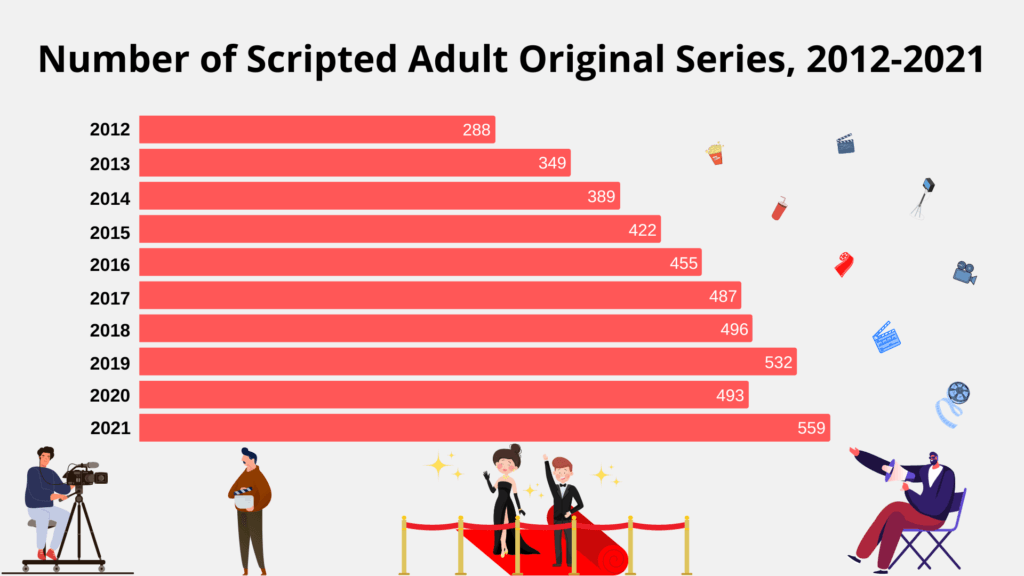
Producers will go to where the money and viewers are, and viewers will go to where the good content is, so it will be interesting to see how this tug of war continues.
What Are People Watching?
People watch a lot of TV, or at least a lot of video content. More specifically, the average American will spend 7 hours and 4 minutes each day looking at something on a screen. What we watch defines many of our lives; that much is clear.
There are more networks, channels, and shows than anyone can keep up with, even if they watch several shows for 24 hours a day. However, while there are many channels or networks, some of them have naturally grown more popular over time.
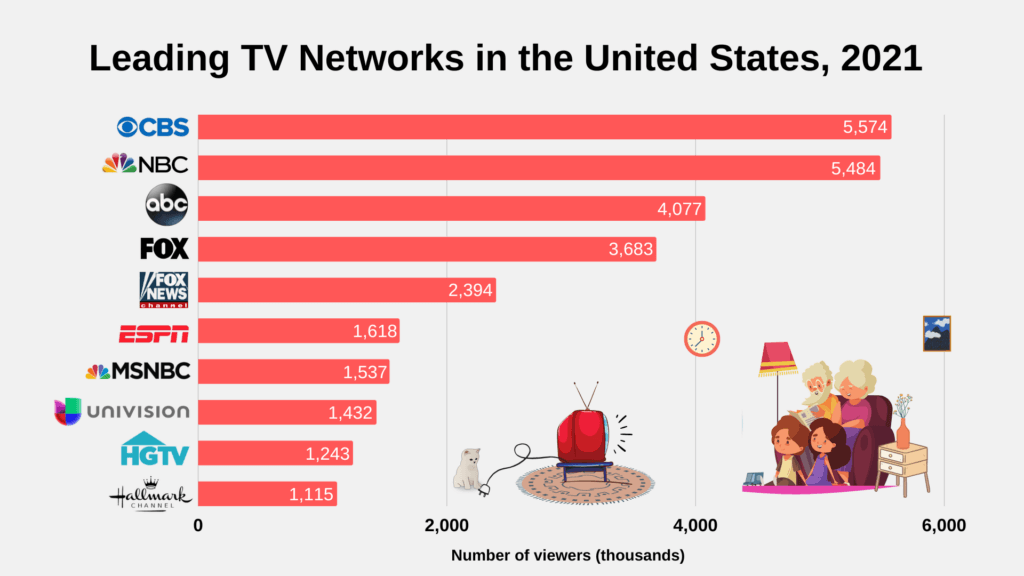
News channels dominate several of the slots, perhaps in part because many people have it on all day, while for other channels, people will only tune in for specific shows. Other than this, some specialized channels, as do the cable mainstays such as ESPN, stick out. Ultimately, we don’t expect these rankings to change terribly over time. While hit shows may come and go, networks like those above tend to have a more static audience, especially those without strong competition.
Is Streaming and On-Demand Television Killing Cable?
There have been drop-offs in cable subscriptions and people saying they’ve “cut the cord” due to the availability of streaming options. Still, the idea that cable TV is dead is an exaggerated and ultimately wrong statement. Cable TV is fine, and we expect it to adapt to fit into the modern world stronger than ever, as it has been trying (to some successes and some failures) over the last decade.
Yet to better understand this, it’s best to look at this debate from several sides. Here are some statistics to help you do just that:
- While we don’t want to exaggerate the fears surrounding cable TV, more people are dropping their pay TV plans in favor of standard broadcast television or another alternative, and the trend is likely to continue.
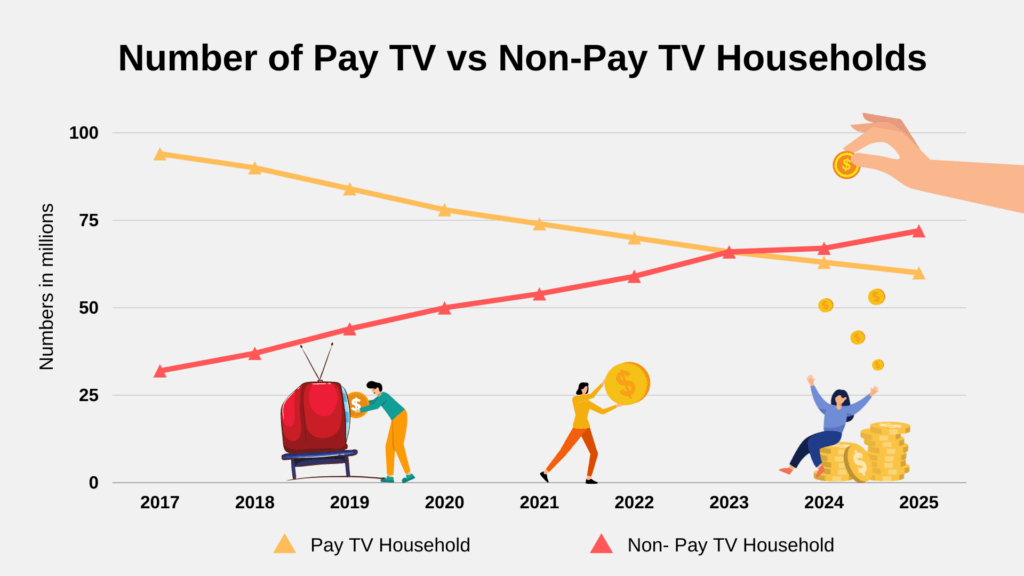
- And while there are plenty of cord cutters, most don’t regret anything. About 52 percent of them don’t feel like they are missing anything after removing cable or satellite TV from their lives. The rest mostly regret live or sports events, which are coincidentally some of the primary revenue sources (either as reasons to subscribe or as separate channel packages) for cable companies.
- Financially, the cable industry and TV providers are still taking in billions. To compare, United States pay TV providers brought in $86.25 billion in revenue in 2020. Netflix took in $30 billion worldwide in 2021 but had a far more thin margin of profit. They’re growing their content, but eventually, Netflix may have to slow down, with other streaming services following suit.
- That being noted, the amount of revenue streaming services are bringing each year is growing and expected to grow further as companies such as Disney enter the market. Equilibrium will likely occur between the two distribution methods, but when this happens is difficult to predict.
- Streaming services in the United States have reached a point of market saturation that has almost reached the same level as cable, with only 25 percent of American adults not subscribed to one yet.
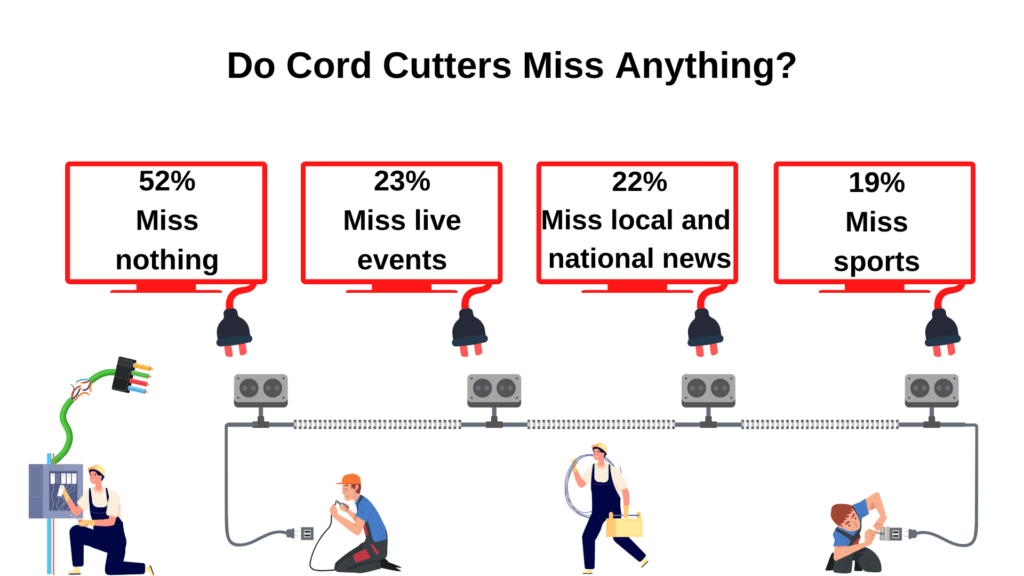
- According to another study, the United States pay TV penetration rate dropped 10 percent from 2014 to 2021. This is a vital statistic and one that cable companies will fight back against with great effort and difficulty. However, as you can tell, the penetration rate is already extremely high, and to predict the immediate demise of the cable industry based on this would be hyperbolic.
There’s a lot more information that one can go through when considering the streaming vs. cable debate (probably the most important one happening in the entertainment industry at the moment).
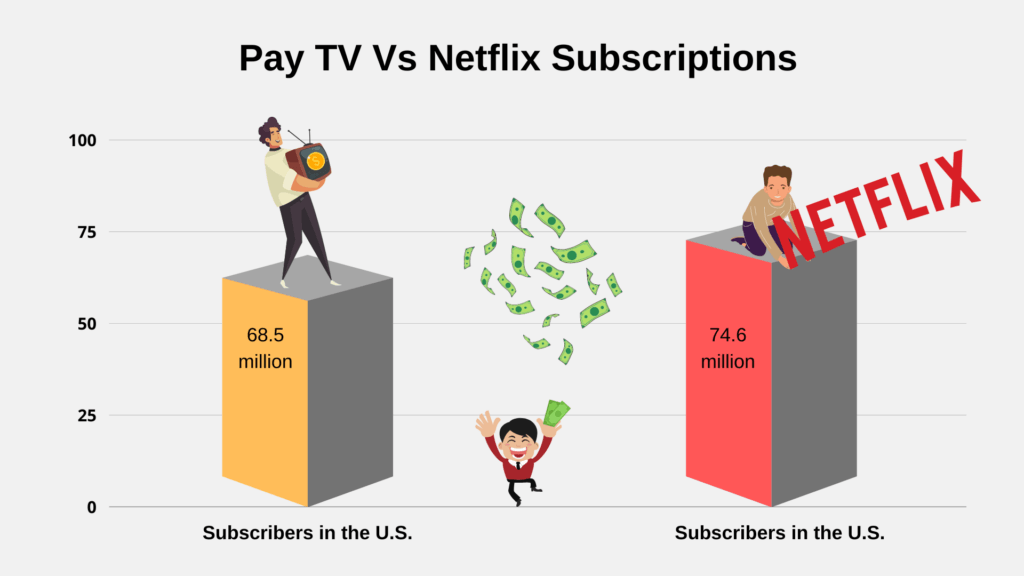
The Top Companies and More About Them
The cable industry is dominated by a top tier of providers who serve millions of households each. By learning more about these companies, we can more easily know where the industry is headed and how to prepare for the future. Cable companies are often jockeying for a position not only for viewers but for dominance in a specific region and, in some cases, will even neglect to compete in favor of companies taking greater root in areas where they already have a foothold.
First, what’s the who’s who of the cable world? Here are the top cable companies or pay-TV providers operating in the United States.
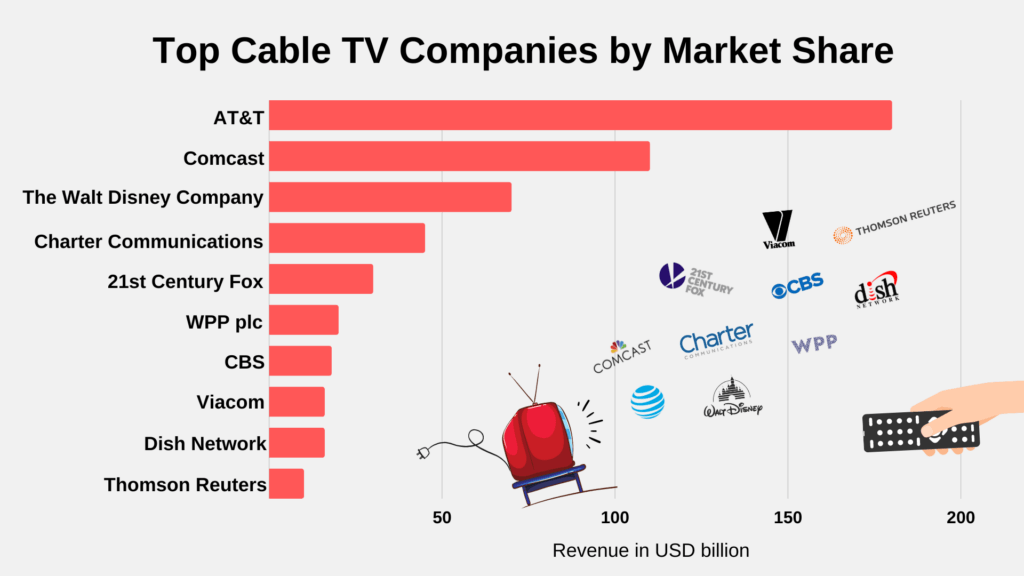
The numbers may shift, but for decades the top companies have remained supreme, with a few significant shifts due to major government policy or regulatory changes allowing telecommunications companies to provide more than one service.
One interesting factor that might interfere with how cable companies do business is that many towns and cities are considering creating locally owned ISPs in response to the near-monopolies telecommunications giants have. Given how cable and internet (and phone) packages are so commonly bundled, many people are reconsidering how they buy cable subscriptions due to this change. Even so, we expect cable companies to adapt instead of disappearing.
Cable TV Around the World
While television and cable TV figures remain relatively stable in the United States (where the service has effectively reached full market saturation), cable TV around the rest of the world continues to grow as an industry and a pastime. While we can’t investigate every country and go into detail about them in the confines of this article, here are a few statistics and trends that will give you the critical takeaways:
- Cable is a major force in Europe and is still, in general, the primary way people watch TV and consume content. By 2027, we can expect that there will be 93 million households with cable TV subscriptions in Eastern Europe. In 2019 that number was 70 million. This amount has nearly tripled in the last ten years, showing remarkable growth. As infrastructure improves, so will the numbers, and plenty of opportunities are left to improve infrastructure.
- In Latin America in 2018, 39 percent of TV households had pay-TV services. These services generated about 19.5 billion in revenue for providers in 2017. Market penetration has increased, and there is still room to grow despite the significant impact the industry has already had there.
- Which countries have the most subscribers?
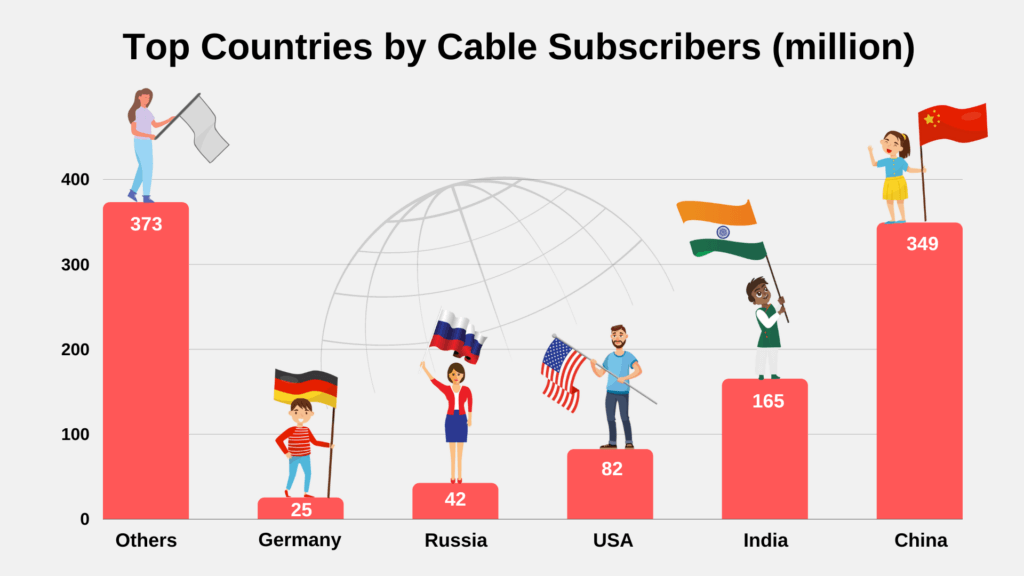
From these statistics, you can generally surmise that while the United States and some western countries have plateaued in terms of growth, you can still expect developments worldwide as other countries catch up to the level of technological advancement and proliferation offered by leading countries. Whether those countries follow a similar trend to the United States or a different path entirely thanks to other digital technologies remains to be seen.
In other cases, smaller countries with a smaller native language base might not get as much focus as they would otherwise have. As such, we might be seeing unpredictable starts and stops in growth as networks figure out and trial how to best expand.
Conclusions
Cable TV is changing alongside our watching habits, but by no means is cable on the decline or dying. On the contrary, we are getting more programming than ever, and people can enjoy what they want when they want due to DVR and on-demand services provided by cable companies, as such. It will be interesting to see how the new decade treats cable and its viewers in conjunction with the rise of online services. Much more could be said, but we hope the information above piqued your interest.







 Call
Call 

 Access Your Account
Access Your Account